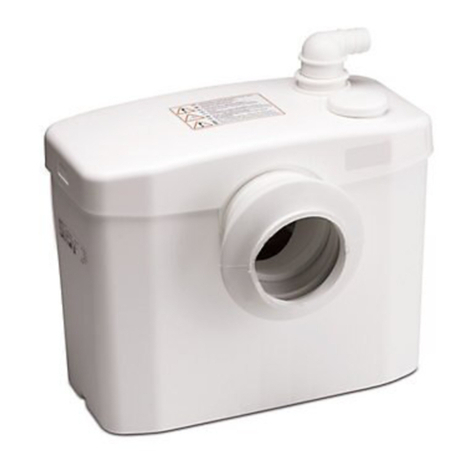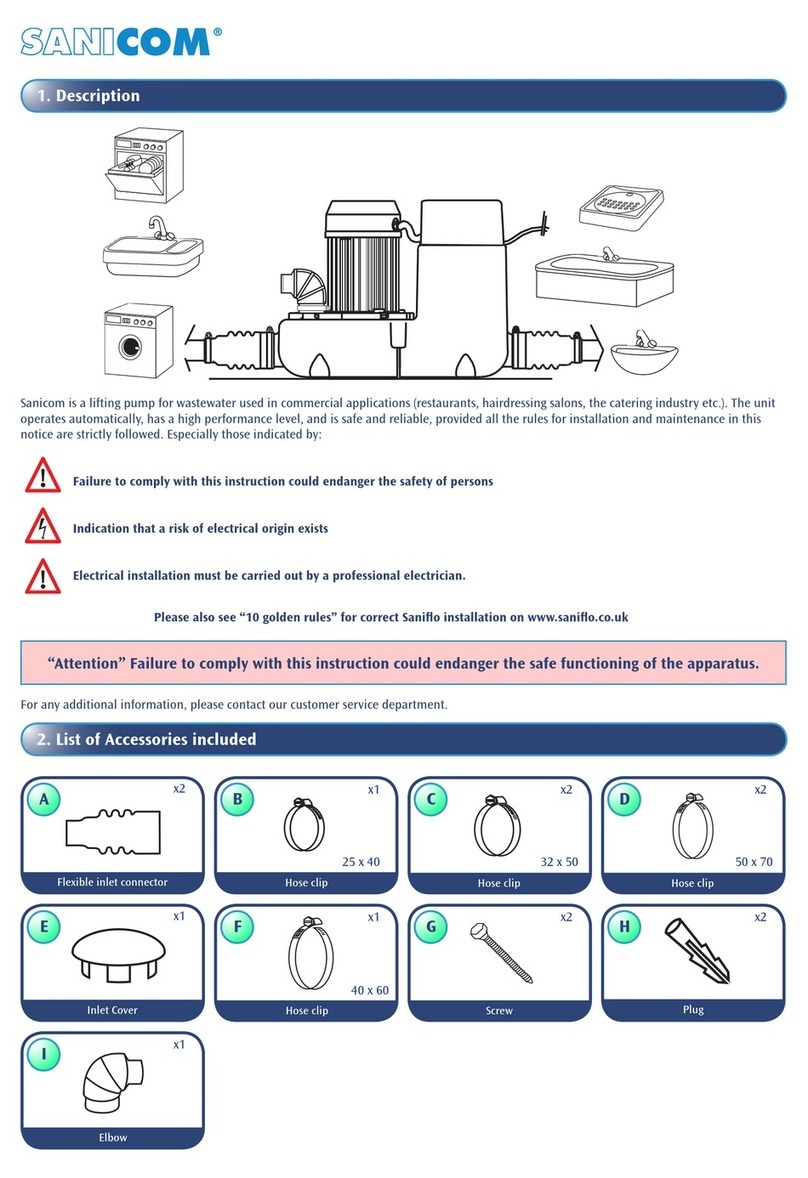
CONTENTS
Copyright / Disclaimer - SANIFOS®Installation and Maintenance
Manual - Original operating instructions.
All rights reserved. The contents of this document must not be
reproduced, modified or disclosed to third parties except upon written
consent from the manufacturer.
This document may be subject to change without notice.
SFA - 41 Bis Avenue Bosquet - 75007 PARIS
1. SAFETY....................................................................... pg.1
1.1 Identifying the warning signs ............................................ pg.2
1.2 General information ........................................................ pg.2
1.3 Intended use.................................................................... pg.3
1.4 Qualification and training of staff....................................... pg.3
1.5
Safety instructions for maintenance,inspection and installation
. pg.3
1.6 Consequences and risks of non-compliance......................... pg.4
with the operating manual
2. TRANSPORT / TEMPORARY STORAGE
RETURN / DISPOSAL.................................................... pg.4
2.1 Receiving inspection......................................................... pg.4
2.2 Transport ........................................................................ pg.4
2.3 Temporary storage / Packaging......................................... pg.5
2.4 Return ............................................................................ pg.5
2.5 Disposal at the end of life ................................................. pg.5
3. DESCRIPTION ............................................................ pg.5
3.1 General description.......................................................... pg.5
3.2 Scope of supply ............................................................... pg.6
3.3 Rating plate..................................................................... pg.7
3.4 Design and operating mode .............................................. pg.7
3.4.1
SANIFOS
®
110 P, SANIFOS
®
280, SANIFOS
®
610 (1 pump)
. pg.7
3.4.2 SANIFOS®610 (2 pumps) and SANIFOS®1300........... pg.7
3.4.3 Technical specifications .............................................. pg.8
3.4.4 Pump curves ............................................................. pg.9
3.4.5 Product dimensions................................................... pg.10
3.5 Sump tank..................................................................... pg.12
3.6 Noise level.................................................................... pg.12
4. PREPARATION OF THE TANK ...............................pg.12
4.1 Preparation for the water inlet pipe ................................. pg.12
4.2 Installation of the pump in the tank .................................. pg.12
4.3 Electrical wiring ............................................................ pg.13
4.3.1 Wiring of pumps and floats ...................................... pg.13
4.3.2 Cable Output ......................................................... pg.15
4.4 Installing the tank cover ................................................. pg.16
4.5 Ventilation .................................................................... pg.16
4.6 Discharge hole ............................................................. pg.17
4.7 Water inlet holes ........................................................... pg.17
5. INSTALLATION / ASSEMBLY ................................pg.17
5.1 Installing the pumping station, floor-standing.................. pg.18
5.2 Installing the pumping station, underground ..................... pg.18
5.3 Adjusting the height of the cover to the ground ................. pg.20
6. SMART CONTROL BOX..........................................pg.21
6.1 Electrical characteristics of the control unit ........................ pg.21
6.2 Technical characteristics of the detection device ................. pg.21
6.3 Dimensions of the SMART remote control box .................... pg.22
6.4 Transport ...................................................................... pg.22
6.5 Connecting the control unit ............................................. pg.22
6.6 Using the SMART Control unit ......................................... pg.24
6.7 Option of connection to an external alarm ....................... pg.26
6.8 Remote wireless alarm box ............................................. pg.27
(delivered with SANIFOS®610 and SANIFOS®1300)
7. COMMISSIONING ..................................................pg.27
7.1 Prerequisites for commissioning........................................ pg.27
7.2 Application limit............................................................. pg.27
7.3 Starting and stopping .................................................... pg.28
7.4 Starting frequency ......................................................... pg.28
7.5 Commissioning with the control box ................................. pg.28
7.6 Operations required for commissioning ............................ pg.28
7.7 Decommissioning ........................................................... pg.29
8. MAINTENANCE .......................................................pg.29
8.1 General information / Safety instructions .......................... pg.29
8.2 Maintenance and inspection operations............................ pg.29
8.3 Maintenance contract ..................................................... pg.30
9. CHECKLIST FOR COMMISSIONING /
INSPECTION (1) AND MAINTENANCE (2)
......................pg.30
9.1 Checklist for commissioning SANIFOS®............................ pg.30
9.2 Checklist for maintenance of SANIFOS®........................... pg.31
Glossary
Clearance
The clearance is the space that needs to be provided for
interventions.
Discharge piping
Piping for raising wastewater above the back-flow level routing
it to the sewer.
Dual station
Pumping station for wastewater equipped with a second pump of
the same power that starts automatically when needed.
Effective volume
Volume to be discharged between the start level and the stop
level.
EN 12050-1
Current European standard for pumping stations for effluents
containing faecal material intended for discharge below the
back-flow level in buildings and on land.
Inlet piping
Line through which wastewater from sanitary fixtures is routed to
the pumping station.
ND (NOMINAL DIAMETER)
Parameter used to characterise parts that are suitable for each
other, for example: pipes, connections, sleeves.
Noise level
Expected sound emissions, expressed in sound pressure level
LpA in dB(A).
Pumping station for wastewater
Facilities for the automatic collection and pumping of
wastewater and blackwater above the back-flow level.
Separator
Equipment which prevents, by gravity, the penetration of
harmful substances into the discharge system by separating
them from wastewater, for example: grease trap.
Ventilation pipe
Ventilation duct limiting pressure variations inside the
wastewater pumping station. The pumping station must be
ventilated from above the roof (when it is installed inside the
house).
Wastewater
Water changed by the use that was made of it (for example:
domestic wastewater).
































